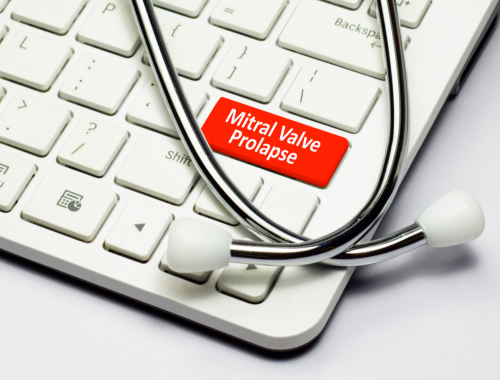Difference Between Mitral Valve Prolapse and Aortic Valve Stenosis

Difference between Mitral valve prolapse and aortic valve stenosis
Mitral valve prolapse is also termed as Floppy valve syndrome. It is a condition in which the mitral valve flaps (leaflets that open and close with each heartbeat to allow the blood flow out of the left atrium – positioned slightly above and behind the right atrium and into the left ventricle – positioned in a posterior and lateral location relative to the right ventricle) become enlarged or stretched
Aortic valve stenosis is an abnormal thickening and narrowing of the left ventricle (the lower left heart chamber) and in this the blood cannot flow normally.

Similarity
Both are conditions of the heart.
Mitral valve prolapse
Mitral valve prolapse is also termed as Barlow syndrome. It is a medical condition in which the mitral valve’s leaflets or cusps (parts of the valve that open and shut to let blood to travel and ensure it does not leak backwards) expand or stretch, causing mitral valve prolapse. These enlarged membranes or valves prolapse (burst) into the left atrium (one of the four chambers of the heart) with each heartbeat as a result of the contraction of the heart.
Aortic valve stenosis
It is a condition in which the aortic valve becomes narrowed and blood is unable to flow normally
Difference between Mitral valve prolapse and aortic valve stenosis
Definition
Mitral valve prolapse
It is a condition in which the leaflets (valve) bulge backwards (like a parachute) into the left upper chamber and the heart contracts.
Aortic valve stenosis
There is narrowing of the valves in the aorta and the blood cannot flow normally.
Symptoms
Mitral valve prolapse
- Abnormal heart rhythm,
- Heart palpitations
- Dizziness or light-headedness
- Arrhythmia
- Tiredness
Aortic valve stenosis
Symptoms of aortic valve stenosis involve:
- Pain in chest termed as Angina
- Tiredness, especially due to strenuous activity
- Feeling of dizziness
- Feeling of fainting
- Heart murmur – an unusual heart sound that can be heard using a stethoscope
- Enlarged heart
- Eating less
- Loss of weight
- Shortness of breath
- Rapid, fluttering heartbeat (palpitations)
End stage symptoms
Mitral valve prolapse
- Palpitations
- Heart beating too fast
Aortic valve stenosis
Syncope (a sudden temporary loss of consciousness), heart failure, anginal chest discomfort
Diagnosis
Mitral valve prolapse
- Echocardiography and cardiovascular imaging techniques
- Transthoracic echocardiogram (TTE)
- Electrocardiogram (ECG or EKG)
- Chest X-ray
- Stress test
Aortic valve stenosis
- Aortic valve replacement
- Transcatheter aortic valve replacement (TAVR)
- Aortic valve repair
- Medications like blood thinners to treat heart rhythm disorders and milder condition of aortic valve stenosis.
Summary
The points of difference between mitral valve prolapse and aortic valve stenosishave been summarized as below:

FAQ:
What is the difference between mitral valve prolapse and stenosis?
Mitral valve prolapse is different from stenosis. The mitral valve is rigid and narrowed in mitral valve stenosis. When the mitral valve tissues are abnormally huge or damaged, the result is mitral valve prolapse, where the valve prolapses or bulges backwards. The reason of mitral valve prolapse is typically unknown.
What is the difference between valve stenosis and valve prolapse?
In stenosis, the heart valve opening narrows and stops blood supply. A valve prolapses when the valve flaps (leaflets) fail to shut tightly.
How to differentiate aortic stenosis and mitral regurgitation?
Aortic stenosis involves narrowing of the aortic valves and that results in restricted blood flow. Mitral regurgitation is also called mitral insufficiency in which mitral valve does not close tightly resulting in backward flow of blood.
What is the difference between mitral and aortic valve stenosis?
Mitral valve stenosis – is a narrowing of the valve (a smaller opening for blood to pass through) between the two left heart chambers.
Aortic valve stenosis – in which there is left ventricle outflow obstruction.
How do you rule out mitral valve prolapse?
By evaluating the heart by:
- Echocardiogram – ultrasound used to assess heart conditions and to check structure and function of your heart
- Chest X-ray – for diagnosing conditions and issues affecting the chest
- Electrocardiogram (ECG or EKG) – records heart’s electrical signals to check different heart conditions through repeated cardiac cycles
- Exercise or stress tests
- Cardiac catheterization – the insertion of a catheter into a vessel of the heart to diagnose any heart condition.
Which is more common aortic stenosis or mitral regurgitation?
In the United States of America, four million individuals are thought to have severe mitral valve regurgitation. In individuals seventy-five and older, mitral valve regurgitation affects about one in ten. Aortic stenosis affects two per cent of the population between sixty-five and seventy-five years and six per cent of those older than seventy five years.
- Difference Between Global Warming and Greenhouse Effect - May 18, 2024
- Difference Between Vaccination and Immunization - March 3, 2024
- Difference Between Selective Mutism and Autism - February 25, 2024
Search DifferenceBetween.net :
Leave a Response
References :
[0]Guy, T. S., & Hill, A. C. (2012). Mitral valve prolapse. Annual review of medicine, 63, 277-292.
[1]Hayek, E., Gring, C. N., & Griffin, B. P. (2005). Mitral valve prolapse. The Lancet, 365(9458), 507-518.
[2]Kanwar, A., Thaden, J. J., & Nkomo, V. T. (2018, April). Management of patients with aortic valve stenosis. In Mayo Clinic Proceedings (Vol. 93, No. 4, pp. 488-508). Elsevier.
[3]Otto, C. M., & Prendergast, B. (2014). Aortic-valve stenosis—from patients at risk to severe valve obstruction. New England Journal of Medicine, 371(8), 744-756.
